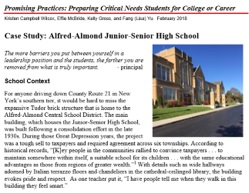Technology to Support Learning: Highlighting Odds-beater Alfred-Almond Junior-Senior High School
By Kristen C. Wilcox
While educators (including family members and other caretakers) look for ways to sustain learning opportunities during the COVID-19 school closures, Alfred-Almond Junior-Senior High School offers some insights. Alfred-Almond was one of seven schools identified for their significantly better graduation outcomes in the NYKids College and Career Readiness study.
Read more about their approaches in this excerpt from the NYKids Alfred-Almond case study.
Technology to Support Learning
When asked about what instruction is expected to look like at Alfred-Almond, leaders used words like “passion,” “interest,” “engagement,” and “interaction.” Having the right technologies and, most importantly, teachers who want to and can use the technologies well are priorities that align to their mission to stay innovative in their teaching. To this end the school has become a G-SUITE (Google) school, and all students, K-12, have a Chromebook assigned to them. To support technology integration, a full-time technology coordinator was hired from within the teaching ranks, and her roles and responsibilities include “know[ing] the curriculum and what the teachers’ needs are”. As one leader explained, “We want to enhance the learning process, and that’s what technology does.”
In addition to this support, teachers are engaged in the decision-making process about what technologies to utilize and have opportunities to pilot new technologies as part of the “Breakfast Club” (a staff get-together). These teachers work with the technology coordinator to try new technologies, and then present the results to the school board and faculty. The piloting of new technologies allows for careful monitoring of what was described as “ease of use” by the technology coordinator. In this way, reluctant students and teachers are more apt to find success and comfort in their growing knowledge of technological tools.
Take-away #1: Allow for Flexible Integration of Technology into Instruction
While some teachers discussed their reluctance to use certain technologies in lieu of more traditional tools, the district allows for flexibility in this regard. One teacher shared that as long as he continues to grow in his instruction, the extent of technology he uses is not dictated:
I can really say I feel like I do what works for me, to the extent that I need to do it. I’m always encouraged to try new things and do more. . .. If I can latch onto a small piece of Google Classroom, then at least I’m giving them [students] digital announcements or I’m doing some piece of that initiative. I think that administratively, we’re happy with that as a way of, “I’m a teacher. I’m making progress. I’m trying something new. I’m learning.”
Take-away #2: Use Technology for Assessment and Feedback
In addition to being used for instruction, technologies are also used for assessment and feedback purposes. Providing meaningful feedback is a schoolwide initiative, and using technology for this purpose enables feedback (as described by teachers) to be in “real time” and “immediate.” This immediate feedback is seen as a “game changer” for all students, by helping to keep students engaged and affording each student, regardless of ability, an opportunity to learn. Special education and Academic Intervention Service (AIS) teachers discussed technology as a way to improve the independence levels of their students and ensure that those students have opportunities to participate when they might not otherwise have done so.
Take-Away #3: Technology as a Resource for Developing Good Cyber-Citizenship Habits
Finally, with a concern for helping their students navigate technology use responsibly, the district has taken up a cyber-citizenship focus. A leader explained what cyber-citizenship is and why it’s important:
It’s being a good citizen online: How do you speak online? How do you connect online? Who do you connect with online? Who don’t you connect with online? And what sorts of things are appropriate for a student to do online? And then, of course, you teach them what different sites do and how they’re meaningful.
Seeing a growing need for these kinds of meaningful discussions and activities about cyber-citizenship in the classroom, Alfred-Almond educators are working to develop a formal curriculum in this area — further evidence of their willingness to stay current and to innovate.
If you would like to read more about Alfred-Almond’s approach to technology integration see the NYKids Alfred-Almond case study.
NYKids will continue to highlight research and provide practical recommendations through our Research-Based Resource Collections during the COVID-19 national emergency. We hope these are useful and welcome comments and suggestions for topics you would like to read more about at nykids@albany.edu.


